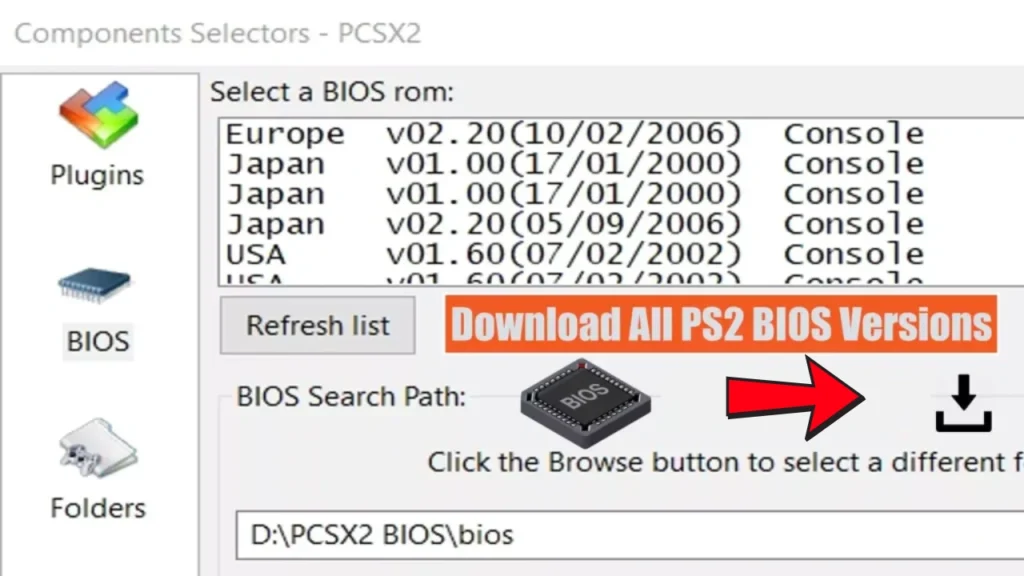The PlayStation 2 holds a legendary place in gaming history. With millions of fans worldwide, it’s no surprise that emulating PS2 games on modern devices has become increasingly popular. But one essential element that many beginners overlook is the BIOS file.
The PS2 BIOS (Basic Input/Output System) acts like the console’s internal software. It’s what allows emulators to mimic how the original PlayStation 2 hardware functions. But here’s the catch—there isn’t just one BIOS file. Depending on your game region, emulator, and hardware setup, the type of BIOS you need may vary.
In this guide, we’ll break down the different types of PS2 BIOS files, how they work, and how to choose the right one for a smooth, legal emulation experience.
Contents
What Exactly Is a PS2 BIOS File?

A PS2 BIOS is a system-level file that comes from the PlayStation 2 console itself. It contains low-level code that manages the console’s hardware: booting up, rendering graphics, handling audio, and ensuring games load properly. Emulators like PCSX2 or AetherSX2 need this BIOS file to function correctly—it’s non-negotiable.
Important: Downloading BIOS files from unofficial sources is illegal. The legal way is to extract the BIOS from your own PS2 console using homebrew tools. This ensures you’re following copyright laws and supporting ethical emulation.
Why Picking the Right BIOS File Matters
Using the wrong BIOS file can lead to all sorts of problems in emulation. Here’s why selecting the correct version is essential:
- Game Compatibility: A mismatch between game region and BIOS region can cause crashes, glitches, or failure to load.
- Performance Issues: Some BIOS versions are tuned for specific hardware and may run poorly if misused.
- Language Settings: BIOS files from different regions often default to local languages, which may be confusing if you can’t read them.
Choosing the correct BIOS helps ensure stable gameplay, accurate visuals, and a more authentic console-like experience.
Also, read PS BIOS Claim Tool
The Main Types of PS2 BIOS Files
1. Regional BIOS Files: NTSC-U, NTSC-J, and PAL
The PlayStation 2 was released in multiple regions, each with its own technical standards. As a result, BIOS files were developed specifically for those markets:
- NTSC-U (North America): Designed for U.S. and Canadian consoles. Uses a 60Hz refresh rate (480i resolution).
- NTSC-J (Japan): Meant for Japanese consoles, similar to NTSC-U but with language and system differences.
- PAL (Europe & Australia): Uses a 50Hz refresh rate with 576i resolution. Needed for games released in PAL regions.
Using a BIOS that matches your game region minimizes compatibility problems and ensures smoother performance.
2. SCPH Model-Based BIOS Versions
Each PlayStation 2 console was released under a model number series called SCPH. These model-based BIOS files reflect hardware upgrades and design changes across PS2 generations.
- SCPH-10000 Series: Early Japanese-only models with basic features. Useful for original launch games from Japan.
- SCPH-30000 Series: More widely available models across Japan, the U.S., and Europe. Highly compatible with most games.
- SCPH-50000 Series: Introduced quieter hardware and improved DVD playback. BIOS includes support for new features.
- SCPH-70000 Series (Slim): Created for the slim PS2 models. These require their own BIOS versions due to hardware changes.
- SCPH-90000 Series: Final PS2 model line with enhanced reliability. BIOS files include cumulative upgrades and performance fixes.
Matching your emulator with the right model version can improve how well it handles specific games or game types.
3. Universal BIOS Packs (Use With Caution)
Some community-made BIOS packs include multiple versions bundled together, letting users switch between regions or models. While convenient, these are often downloaded from unauthorized sources and may not be legal in your country. Always use your own dumped BIOS if possible.
How to Choose the Right PS2 BIOS File
To find the best BIOS for your needs, consider:
- Game Region: Match your BIOS region (NTSC-U, PAL, etc.) with the game you plan to play.
- Hardware Version: If your game was released for the slim PS2, use a BIOS from the SCPH-70000 or SCPH-90000 series.
- Language Settings: Want to change the system language? Some BIOS files offer multilingual options.
- Legal Access: Always extract your BIOS from your own console to stay on the right side of copyright law.
Also, read How to Set Up PS2 BIOS in RetroArch for Android & iOS
How to Extract Your Own PS2 BIOS Legally
The most ethical method to get a PS2 BIOS is by dumping it directly from your console. This process typically involves:
- A USB flash drive or memory card
- Free homebrew software like BIOS Dumper or uLaunchELF
- A tutorial (easily found online) specific to your PS2 model
Following this method ensures you’re emulating responsibly and legally.
Also, read Best PS2 Emulators for PC
Conclusion
Understanding the different types of PS2 BIOS files is key to getting the most out of your emulation setup. Whether you’re playing nostalgic childhood favorites or exploring games from other regions, the right BIOS ensures smooth, accurate gameplay that stays true to the original console.
By choosing the correct file and extracting it legally from your own system, you’ll enjoy a safer, more reliable, and ethically sound gaming experience—one that helps keep the PlayStation 2 legacy alive for future generations.
Jaiden Smith
Hi, I’m Jaiden Smith — the owner of PSBIOS.us. I’ve built this platform to make it easy and safe for users to access PlayStation BIOS files for emulators. Whether you're looking to enhance your retro gaming setup or just need a reliable BIOS source, I personally ensure everything here is clean, secure, and up-to-date.

